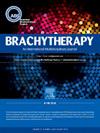HDR和PDR近距离治疗面部非黑色素瘤皮肤癌:155例患者的预后和毒性评估
IF 1.8
4区 医学
Q4 ONCOLOGY
引用次数: 0
摘要
非黑色素瘤皮肤癌(NMSC),包括基底细胞癌和鳞状细胞癌,是世界上最常见的恶性肿瘤之一。虽然手术是治疗早期病变的标准方法,但对于面部围周肿瘤,手术可能会毁容。目的:评估在综合癌症中心接受近距离放射治疗的面部NMSC患者的局部和区域控制以及毒性结果。材料与方法:共纳入155例患者。其中,115例为鳞状细胞癌,34例为基底细胞癌。唇部是最常见的部位(103例),其次是鼻子(49例)。128例患者接受近距离放射治疗,27例患者接受辅助治疗。结果:24个月时,局部控制率为93.9% (95% CI: 89.4 ~ 98.5%),局部控制率为90.3% (95% CI: 84.8 ~ 96.1%)。未见≥3级晚期毒性。结论:对于面部NMSC,近距离放射治疗是一种安全有效的器官保存选择,特别是对于解剖结构复杂的病变或手术禁忌症患者。本文章由计算机程序翻译,如有差异,请以英文原文为准。
HDR and PDR brachytherapy for facial nonmelanoma skin cancer: Outcome and toxicity assessment for 155 patients
Introduction
Nonmelanoma skin cancer (NMSC), encompassing basal and squamous cell carcinomas, is among the most common malignancies worldwide. While surgery is the standard for early-stage lesions, it can be disfiguring for periorificial facial tumors.
Objective
To assess local and regional control, as well as toxicity outcomes, in patients with facial NMSC treated by brachytherapy at a comprehensive cancer center.
Materials and Methods
A total of 155 patients were included. Of these, 115 had squamous cell carcinoma and 34 had basal cell carcinoma. The lip was the most frequent site (103 cases), followed by the nose (49 cases). Brachytherapy was exclusive in 128 patients and adjuvant in 27.
Results
At 24 months, local and locoregional control rates were 93.9% (95% CI: 89.4–98.5%) and 90.3% (95% CI: 84.8–96.1%) respectively. No grade ≥3 late toxicity was observed.
Conclusion
Brachytherapy is a safe and effective organ-preserving option for facial NMSC, particularly in patients with anatomically complex lesions or contraindications to surgery.
求助全文
通过发布文献求助,成功后即可免费获取论文全文。
去求助
来源期刊

Brachytherapy
医学-核医学
CiteScore
3.40
自引率
21.10%
发文量
119
审稿时长
9.1 weeks
期刊介绍:
Brachytherapy is an international and multidisciplinary journal that publishes original peer-reviewed articles and selected reviews on the techniques and clinical applications of interstitial and intracavitary radiation in the management of cancers. Laboratory and experimental research relevant to clinical practice is also included. Related disciplines include medical physics, medical oncology, and radiation oncology and radiology. Brachytherapy publishes technical advances, original articles, reviews, and point/counterpoint on controversial issues. Original articles that address any aspect of brachytherapy are invited. Letters to the Editor-in-Chief are encouraged.
 求助内容:
求助内容: 应助结果提醒方式:
应助结果提醒方式:


